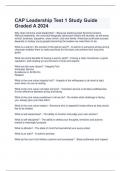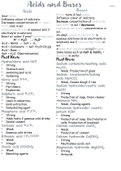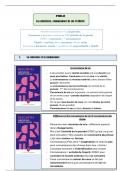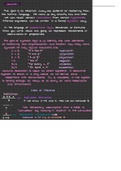Sample Questions and Solutions
#1 to #76
In this version, standard normal distribution values are obtained by using the
Cumulative Normal Distribution Calculator and Inverse CDF Calculator provided in
http://www.prometric.com/SOA/MFE3F_calculator.htm
1 April 8, 2011
,1. Consider a European call option and a European put option on a nondividend-paying
stock. You are given:
(i) The current price of the stock is 60.
(ii) The call option currently sells for 0.15 more than the put option.
(iii) Both the call option and put option will expire in 4 years.
(iv) Both the call option and put option have a strike price of 70.
Calculate the continuously compounded risk-free interest rate.
(A) 0.039
(B) 0.049
(C) 0.059
(D) 0.069
(E) 0.079
2 April 8, 2011
,Solution to (1) Answer: (A)
The put-call parity formula (for a European call and a European put on a stock with the
same strike price and maturity date) is
C P F0,PT ( S ) F0,PT ( K )
F0,PT ( S ) PV0,T (K)
F0,PT ( S ) KerT
= S0 KerT,
because the stock pays no dividends
We are given that C P 0.15, S0 60, K 70 and T 4. Then, r 0.039.
Remark 1: If the stock pays n dividends of fixed amounts D1, D2,…, Dn at fixed times t1,
t2,…, tn prior to the option maturity date, T, then the put-call parity formula for European
put and call options is
C P F0,PT ( S ) KerT
S0 PV0,T(Div) KerT,
where PV0,T(Div) Di e i is the present value of all dividends up to time T. The
rt
n
i 1
difference, S0 PV0,T(Div), is the prepaid forward price F0P,T ( S ) .
Remark 2: The put-call parity formula above does not hold for American put and call
options. For the American case, the parity relationship becomes
S0 PV0,T(Div) K ≤ C P ≤ S0 KerT.
This result is given in Appendix 9A of McDonald (2006) but is not required for Exam
MFE/3F. Nevertheless, you may want to try proving the inequalities as follows:
For the first inequality, consider a portfolio consisting of a European call plus an amount
of cash equal to PV0,T(Div) + K.
For the second inequality, consider a portfolio of an American put option plus one share
of the stock.
3 April 8, 2011
, 2. Near market closing time on a given day, you lose access to stock prices, but some
European call and put prices for a stock are available as follows:
Strike Price Call Price Put Price
$40 $11 $3
$50 $6 $8
$55 $3 $11
All six options have the same expiration date.
After reviewing the information above, John tells Mary and Peter that no arbitrage
opportunities can arise from these prices.
Mary disagrees with John. She argues that one could use the following portfolio to
obtain arbitrage profit: Long one call option with strike price 40; short three call
options with strike price 50; lend $1; and long some calls with strike price 55.
Peter also disagrees with John. He claims that the following portfolio, which is
different from Mary’s, can produce arbitrage profit: Long 2 calls and short 2 puts
with strike price 55; long 1 call and short 1 put with strike price 40; lend $2; and
short some calls and long the same number of puts with strike price 50.
Which of the following statements is true?
(A) Only John is correct.
(B) Only Mary is correct.
(C) Only Peter is correct.
(D) Both Mary and Peter are correct.
(E) None of them is correct.
4 April 8, 2011






